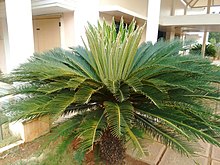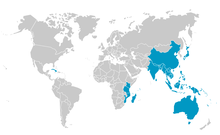
Cycas
|
Cycas Temporal range:
| |
|---|---|

| |
| A large cycas under development | |
|
Scientific classification | |
| Kingdom: | Plantae |
| Clade: | Tracheophytes |
| Clade: | Gymnosperms |
| Division: | Cycadophyta |
| Class: | Cycadopsida |
| Order: | Cycadales |
| Suborder: | Cycadineae |
| Family: |
Cycadaceae Pers. |
| Genus: |
Cycas L. |
| Type species | |
|
C. circinalis L.
| |

| |
| Synonyms | |
| |
Cycas is a genus of cycad, and the only genus in the family Cycadaceae. About 113 species are accepted, which are native to the Asia-Pacific, East Africa and Madagascar.Cycas circinalis, a species endemic to India, was the first cycad species to be described in western literature, and is the type species of the genus. The best-known Cycas species is Cycas revoluta.
Range
The genus is native to the Old World, with the species concentrated around the equatorial regions - eastern and southeastern Asia including the Philippines with 10 species (9 of which are endemic), eastern Africa (including Madagascar), northern Australia, Polynesia, and Micronesia. Australia has 26 species, while the Indo-Chinese area has about 30. India has 9 species. The northernmost species (C. revoluta) is found at 31°N in southern Japan. The southernmost (C. megacarpa) is found at 26°S in southeast Queensland. Due to the occurrence of large number of Cycas species in China, Australia and India, those countries are considered as centres of Cycas diversity.
Evolution
Cycas is though to have split from all other living cycads at least 200 million years ago, possibly much earlier. Fossil seeds from the Middle Jurassic of England and British Columbia were suggested in a 2017 study to be more closely related to Cycas than other cycads, and were assigned to the same family, Cycadaceae. However, a later study suggested that these seeds could not be assigned to the stem-group of Cycas with confidence due to lacking the double vascular system that characterises the seeds of all living cycads. The earliest fossils assignable to Cycas are known from the Paleogene of East Asia, such as Cycas fushunensis from the Eocene of Northeast China, with East Asia likely representing the ancestral homeland of the genus.
Morphology
The plants are dioecious, and the family Cycadaceae is unique among the cycads in not forming seed cones on female plants, but rather a group of leaf-like structures called megasporophylls each with seeds on the lower margins, and pollen cones or strobilus on male individuals.
The caudex is cylindrical, surrounded by the persistent petiole bases. Most species form distinct branched or unbranched trunks but in some species the main trunk can be subterranean with the leaf crown appearing to arise directly from the ground. There are two types of leaves - foliage leaves and scaly leaves. The foliage leaves are pinnate (or more rarely bipinnate) and arranged spirally, with thick and hard keratinose. They are not permanent and fall off leaving back leaf-bases. The leaflets are articulated, have midrib but lack secondary veins. The scaly leaves are persistent, brown in colour and protective in function. Megasporophylls are not gathered in cones. Pollination takes place by air.
Reproduction


Cykas take about 10 years to reach sexual maturity, after years of exclusive vegetative growth, which occurs by bulbils arising at the base of the trunk.
Conservation status
Cycas species are threatened worldwide and almost all the species are listed in the IUCN Red List. Cycas beddomei is the only species of the genus Cycas listed in Appendix I of CITES. Cycas rumphii and Cycas pectinata have the most widespread distribution.
Phylogeny

| Phylogeny of Cycas | ||||||||||||||||||||||||||||||||||||||||||||||||||||||||||||||||||||||||||||||||||||||||||||||||||||||||||||||||||||||||||||||||||||||||||||||||||||||||||||||||||||||||||||||||||||||||||||||||||||||||||||||||||||||||||||||||||||||||||||||||||||||||||||||||||||||||||||||||||||||||||||||||||||||||||||||||||||||||||||||||||||||||||||||||||||||||||||||||||||||||||||||||||||||||||||||||||||||||||||||||||||||||||||||||||||||||||
|---|---|---|---|---|---|---|---|---|---|---|---|---|---|---|---|---|---|---|---|---|---|---|---|---|---|---|---|---|---|---|---|---|---|---|---|---|---|---|---|---|---|---|---|---|---|---|---|---|---|---|---|---|---|---|---|---|---|---|---|---|---|---|---|---|---|---|---|---|---|---|---|---|---|---|---|---|---|---|---|---|---|---|---|---|---|---|---|---|---|---|---|---|---|---|---|---|---|---|---|---|---|---|---|---|---|---|---|---|---|---|---|---|---|---|---|---|---|---|---|---|---|---|---|---|---|---|---|---|---|---|---|---|---|---|---|---|---|---|---|---|---|---|---|---|---|---|---|---|---|---|---|---|---|---|---|---|---|---|---|---|---|---|---|---|---|---|---|---|---|---|---|---|---|---|---|---|---|---|---|---|---|---|---|---|---|---|---|---|---|---|---|---|---|---|---|---|---|---|---|---|---|---|---|---|---|---|---|---|---|---|---|---|---|---|---|---|---|---|---|---|---|---|---|---|---|---|---|---|---|---|---|---|---|---|---|---|---|---|---|---|---|---|---|---|---|---|---|---|---|---|---|---|---|---|---|---|---|---|---|---|---|---|---|---|---|---|---|---|---|---|---|---|---|---|---|---|---|---|---|---|---|---|---|---|---|---|---|---|---|---|---|---|---|---|---|---|---|---|---|---|---|---|---|---|---|---|---|---|---|---|---|---|---|---|---|---|---|---|---|---|---|---|---|---|---|---|---|---|---|---|---|---|---|---|---|---|---|---|---|---|---|---|---|---|---|---|---|---|---|---|---|---|---|---|---|---|---|---|---|---|---|---|---|---|---|---|---|---|---|---|---|---|---|---|---|---|---|---|---|---|---|---|---|---|---|---|---|---|---|---|---|---|---|---|---|---|---|---|---|---|---|---|---|---|---|---|---|---|---|---|---|---|---|---|---|---|---|---|---|---|---|---|---|---|---|---|
|
Other species:
- Cycas aenigma Hill & Lindström
- Cycas apoa Hill
- Cycas arnhemica Hill
- Cycas badensis Hill
- Cycas bglswamyi Pant ex Agrawal, Akhtar & R.C.Srivast.
- Cycas brunnea Hill
- Cycas campestris Hill
- Cycas candida Hill
- Cycas cantafolia Jutta, Chew & Saw
- Cycas changjiangensis Liu
- Cycas chenii Gong & Zhou
- Cycas collina Hill, Nguyên & Lôc
- Cycas cupida Forster
- Cycas darshii Srivastava & Jana
- Cycas desolata Forster
- Cycas dharmrajii Singh
- Cycas distans P.I.Forst. & B.Gray
- Cycas divyadarshanii Khuraijam & Rita Singh
- Cycas elephantipes Lindström & Hill
- Cycas falcata Hill
- Cycas flabellata Agoo, Madulid & Callado
- Cycas fugax Hill, Nguyên & Lôc
- Cycas furfuracea W.Fitzg.
- Cycas glauca Miquel
- Cycas hoabinhensis Lôc & Nguyên
- Cycas inermis Oudem.
- Cycas javana (Miquel) de Laubenfels
- Cycas lacrimans Lindström & Hill
- Cycas lane-poolei
- Cycas laotica Nguyên & Nguyên
- Cycas litoralis Hill
- Cycas mindanaensis Agoo, Madulid & Callado
- Cycas miquelii Warburg
- Cycas montana Lindström & Hill
- Cycas nayagarhensis Rita Singh, Radha & Khuraijam
- Cycas nathorstii Schuster
- Cycas orixensis (Haines) Rita Singh & Khuraijam
- Cycas pachypoda Hill
- Cycas panzhihuaensis Zhou & Yang
- Cycas papuana von Mueller
- Cycas pranburiensis Yang et al.
- Cycas pruinosa Maconochie
- Cycas sainathii Srivastava
- Cycas sancti-lasallei Agoo & Madulid
- Cycas saxatilis Hill & Lindström
- Cycas scratchleyana von Mueller
- Cycas seemannii A.Braun
- Cycas seshachalamensis Rao et al.
- Cycas sexseminifera Wei
- Cycas shanyaensis Fu
- Cycas sundaica Miquel ex Lindström & Hill
- Cycas terryana Forster
- Cycas tuckeri Hill
- Cycas xipholepis Hill
- Cycas yorkiana Hill
- Cycas yunnanensis Cheng, Fu & Cheng
- Cycas zambalensis Madulid & Agoo
- Cycas zeylanica (Schuster) Lindström & Hill
External links
- de Laubenfels, D.J.; Adema, F. (1998). "A taxonomic revision of the genera Cycas and Epicycas Gen. Nov. (Cycadaceae)". Blumea. 43: 351–400.
- Hill, K.D.(1998–2004) The Cycad Pages, Royal Botanic Gardens Sydney. http://plantnet.rbgsyd.nsw.gov.au/PlantNet/cycad/index.html Archived 2021-03-29 at the Wayback Machine
- Virtual Cycad Encyclopedia edited by the Palm & Cycad Societies of Florida
- David, J. de Laubenfels, Cycas Taxonomy
- Hill, K.D.; Stevenson, Dennis W.; Osborne, Roy (2004). "The World List of Cycads". The Botanical Review. 70 (2): 274–298. doi:10.1663/0006-8101(2004)070[0274:TWLOC]2.0.CO;2. S2CID 36921733.
- Lindstrom, Anders J.; Hill, Ken D. (2007). "The genus Cycas (Cycadaceae) in India". Telopea. 11 (4): 463–488. doi:10.7751/telopea20075745.
- Singh, R & JS Khuraijam (2013-) Cycads of India. http://www.cycadsofindia.in/
- Singh, R.; Radha, P.; Khuraijam, J.S. (2015). "A new species, a new combination and a new subsection of Cycas from Odisha, northern Eastern Ghats of India". Asian Journal of Conservation Biology. 4 (1): 3–14.
- Singh, R.; Radha, P. (2006). "Cycas annaikalensis, A new species of Cycas from the Malabar Coast, Western Ghats, India". Brittonia. 58 (2): 119–123. doi:10.1663/0007-196x(2006)58[119:ansocf]2.0.co;2. S2CID 32241023.
- Terrence Walters & Roy Osborne (eds.) (2004), Cycad Classification: Concepts and Recommendations, CABI publishing, ISBN 0-85199-741-4
|
Classification of Archaeplastida or Plantae
| |||||||||||||||||||||||||||||||||||||||||||||||||||
|---|---|---|---|---|---|---|---|---|---|---|---|---|---|---|---|---|---|---|---|---|---|---|---|---|---|---|---|---|---|---|---|---|---|---|---|---|---|---|---|---|---|---|---|---|---|---|---|---|---|---|---|
| |||||||||||||||||||||||||||||||||||||||||||||||||||
| |||||||||||||||||||||||||||||||||||||||||||||||||||
|
Classification of Acrogymnospermae (living Gymnosperms)
| |||||||||||||||||||||||||||||||||||||||||||||||||||||||||||||||||||||||||||
|---|---|---|---|---|---|---|---|---|---|---|---|---|---|---|---|---|---|---|---|---|---|---|---|---|---|---|---|---|---|---|---|---|---|---|---|---|---|---|---|---|---|---|---|---|---|---|---|---|---|---|---|---|---|---|---|---|---|---|---|---|---|---|---|---|---|---|---|---|---|---|---|---|---|---|---|
| |||||||||||||||||||||||||||||||||||||||||||||||||||||||||||||||||||||||||||
| Taxon identifiers |
|
|---|



